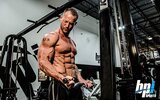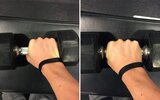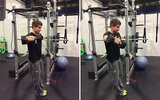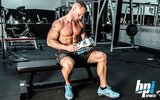01dragonslayer
Ripped
- Jacked Cash
- 472,175
If you’ve ever experienced shoulder pain, then you know how tricky it can be to build those cannonball delts. Given our culture’s sedentary lifestyle and the fact that many folks seem to struggle with maintaining overhead shoulder function, it’s no wonder that impingement is rampant within the weight lifting community.
However, this isn’t always a bad thing as the shoulder was designed to move in a variety of planes provided the body has the necessary mobility and stability. The musculature of the neck, upper back, and rotator cuff all play synergistic roles when seeking optimal shoulder development. The following strategies are designed to place your body in the most biomechanically advantageous position for growth.

If there’s one point I try to hammer home to all of my clients and athletes, it’s the fact that joint position affects muscular activation.
In the case of the shoulders, this means that if you lack appropriate congruency of the scapula with the thoracic spine, you’ll never generate reflexive stability in the muscles of the rotator cuff. Thus, simply hammering all sorts of internal and external rotations isn’t going to do anything if you don’t address ribcage position.
How? The short and simple answer is breathing. When you inhale, the diaphragm and intercostals must work in conjunction to generate expansion of the ribcage and abdomen. The thoracic spine must maintain a position of slightly flexion (30-40°) in order to optimize expansion but if you’re like most athletes, you’re locked into a heavily extended position with overactive lats, spinal erectors, and poor anterior core stability.
Can you get stronger like this? Sure, but in the long run you’re going to place an excessively large amount of shear force upon the spine, which could potentially result in disc issues later on in life.
Breathing tends to be a hot topic these days but for good reason, it’s the foundation for all movement. If you struggle with shoulder pain or scapular dysfunction then seek to address breathing mechanics and core stability first rather than looking at the shoulder with a “stretch this, strength that” simplistic mindset.

During any sort of overhead activity, the upper trap, lower trap, and serratus anterior must fire simultaneously in order to provide upward rotation of the scapula. This force couple is present in order to allow proper scapula-humeral rhythm but if you’re focused on packing the shoulder, you’ll never acquired proper ball and socket congruency.
However, if you choose to utilize bands you will notice that this strength curve is altered dramatically; the movement becomes most difficult at the peak of contraction. As such, you can generate a higher level of intramuscular tension throughout the entire range of motion.
Facepulls have been around forever, but the majority of folks don’t know to perform them correctly. So, I utilize one small tweak: maintain a half kneeling stance to keep the lumbar spine out of extension and ensure the rear deltoids do the majority of the work. Make sure to squeeze the glute on the extended leg and don’t let yourself lean back as you get tired.
Also, if you’re tired of the generic lateral raise with dumbbells, try out this unique version, which incorporates all 3 planes of motion:
For shrug and rear deltoid variations, experiment by looking up or down to partially contract or stretch the upper trap before you move the shoulder girdle. Ideally, I like to look down on movements like face-pulls to decrease trap involvement and ensure the posterior deltoid does all of the work. Likewise, I enjoy looking up during shrugs, which seems to enhance the contraction.
Head positioning is something that varies quite a bit among lifters but try both options and see which one feels better, your body knows best.
Note: Do not try to alter neck position during high-velocity movements such as power shrugs. Adjustments in head position create alterations in additional spinal segments and thus should only be utilized under controlled, lower speed movements (i.e. DB shrugs, facepulls, etc).
Given the fact most guys CRUSH bench and pull-ups, it’s likely that the internal rotators are quite tight in the majority of the population. When the shoulder becomes internally rotated, you close down the subacromial space and the chance for impingement greatly increases.
If you got lost in all of the anatomical jargon, don’t worry about the mechanism behind impingement. Instead, just make some adjustments to your training and work to get pain free!

Essentially, you’re effectively increasing the range of motion for the lift by utilizing a larger arc and allowing the medial deltoids to remain under tension throughout the entirety of the movement. If you’re still not tracking with me, check out the video below which might give you a better idea.

Well here’s your answer, an entire MONTH of programming laid out for you.
Before we get to the actual workout schedule, I've written some coaching cues for you to keep in mind while performing these exercises.

Now the question is, what’s more important: more weight on the bar or longevity in your training?
Ligaments, Tendons, and Bone - Oh My!
The shoulder girdle is one of more unstable regions of your body, given the scapula has a “floating” position atop the ribcage and lacks any direct bony attachments. Some refer to its positioning as “a golf ball on top of a tee” given the ball and socket joint configuration.However, this isn’t always a bad thing as the shoulder was designed to move in a variety of planes provided the body has the necessary mobility and stability. The musculature of the neck, upper back, and rotator cuff all play synergistic roles when seeking optimal shoulder development. The following strategies are designed to place your body in the most biomechanically advantageous position for growth.

Position Affects Activation
First thing’s first, we’ve got to discuss some basics regarding shoulder development.If there’s one point I try to hammer home to all of my clients and athletes, it’s the fact that joint position affects muscular activation.
In the case of the shoulders, this means that if you lack appropriate congruency of the scapula with the thoracic spine, you’ll never generate reflexive stability in the muscles of the rotator cuff. Thus, simply hammering all sorts of internal and external rotations isn’t going to do anything if you don’t address ribcage position.
How? The short and simple answer is breathing. When you inhale, the diaphragm and intercostals must work in conjunction to generate expansion of the ribcage and abdomen. The thoracic spine must maintain a position of slightly flexion (30-40°) in order to optimize expansion but if you’re like most athletes, you’re locked into a heavily extended position with overactive lats, spinal erectors, and poor anterior core stability.
Can you get stronger like this? Sure, but in the long run you’re going to place an excessively large amount of shear force upon the spine, which could potentially result in disc issues later on in life.
Breathing tends to be a hot topic these days but for good reason, it’s the foundation for all movement. If you struggle with shoulder pain or scapular dysfunction then seek to address breathing mechanics and core stability first rather than looking at the shoulder with a “stretch this, strength that” simplistic mindset.

6 Tips To Help Maximize Shoulder Development
Since spending countless hours on forums and browsing conversations between some of the top coaches in the nation, I’ve picked up quite a few cues and tips that can help you maximize your shoulder development without having to fight through constant pain and aggravation.1. Stop packing the shoulders during overhead work. Instead, think about “reaching tall” at the top.
I’ve heard many coaches use this cue with clients to maintain an “active” shoulder position while pressing but it always makes me scratch my head when I think about it biomechanically.During any sort of overhead activity, the upper trap, lower trap, and serratus anterior must fire simultaneously in order to provide upward rotation of the scapula. This force couple is present in order to allow proper scapula-humeral rhythm but if you’re focused on packing the shoulder, you’ll never acquired proper ball and socket congruency.
2. Utilize bands for lateral raises and face-pulls.
Most weight machines, share the same standard strength curve - the movements are easiest at the top and bottom of the rep (side note: this can also be attributed to length-tension relationships created by the optimization of cross bridges within individual muscle fibers but for the scope of this article we’ll keep our discussion based upon physics rather than anatomy.)However, if you choose to utilize bands you will notice that this strength curve is altered dramatically; the movement becomes most difficult at the peak of contraction. As such, you can generate a higher level of intramuscular tension throughout the entire range of motion.
Facepulls have been around forever, but the majority of folks don’t know to perform them correctly. So, I utilize one small tweak: maintain a half kneeling stance to keep the lumbar spine out of extension and ensure the rear deltoids do the majority of the work. Make sure to squeeze the glute on the extended leg and don’t let yourself lean back as you get tired.
Also, if you’re tired of the generic lateral raise with dumbbells, try out this unique version, which incorporates all 3 planes of motion:
3. Optimize head positioning.
The upper fibers of the trapezius attach to the base of the skull via the occipital bone and control a variety of movements including extension of the neck (i.e. looking up). Using this knowledge of positioning, we can influence muscle activation by looking up or down which alters the length of the upper trapezius.For shrug and rear deltoid variations, experiment by looking up or down to partially contract or stretch the upper trap before you move the shoulder girdle. Ideally, I like to look down on movements like face-pulls to decrease trap involvement and ensure the posterior deltoid does all of the work. Likewise, I enjoy looking up during shrugs, which seems to enhance the contraction.
Head positioning is something that varies quite a bit among lifters but try both options and see which one feels better, your body knows best.
Note: Do not try to alter neck position during high-velocity movements such as power shrugs. Adjustments in head position create alterations in additional spinal segments and thus should only be utilized under controlled, lower speed movements (i.e. DB shrugs, facepulls, etc).
4. Grip lower on the dumbbell and allow your pinky to touch the outside of the bell.
This is a little tweak but can make a big difference in terms of muscular recruitment. Essentially, by shifting the majority of the weight to the posterior aspect of your hand, you increase demand from the external rotators within the shoulder.Given the fact most guys CRUSH bench and pull-ups, it’s likely that the internal rotators are quite tight in the majority of the population. When the shoulder becomes internally rotated, you close down the subacromial space and the chance for impingement greatly increases.
If you got lost in all of the anatomical jargon, don’t worry about the mechanism behind impingement. Instead, just make some adjustments to your training and work to get pain free!

5. Implement single arm leaning lateral raises.
Hold onto a squat rack with your free arm, lean away to place all of the emphasis on one shoulder, and perform normal lateral raises. Given that the biomechanics for this lift are a bit different, you’ll probably notice some significant differences. Whenever normal lateral raises give me pain, I substitute with these and they make my shoulders feel 10x better.Essentially, you’re effectively increasing the range of motion for the lift by utilizing a larger arc and allowing the medial deltoids to remain under tension throughout the entirety of the movement. If you’re still not tracking with me, check out the video below which might give you a better idea.
6. Lean slightly forward and keep your pinkies higher than your thumbs - Imagine pouring out the dumbbell like a pitcher of water.
This little tip is something I picked up while reading a few of Brad Schoenfeld’s articles. This position internally rotates the shoulder and emphasizes more of the posterior and medial deltoids, as they must fire to move the load against gravity.
Putting It All Together: All Gain, No Pain
So, I’ve laid out the foundation (breathing and ribcage positioning) and I’ve also provided some cueing and biomechanical modifications that we can use to improve activation and decrease pain. But, now the question is - “Where do I go from here?”Well here’s your answer, an entire MONTH of programming laid out for you.
Before we get to the actual workout schedule, I've written some coaching cues for you to keep in mind while performing these exercises.
Standing Push Press:
- Squeeze your glutes, take a big breath, and then brace your abs like someon is about to punch you in the stomach before initiating movement.
- Dip and drive.
- Pack your neck: "Make a double chin!"
- Push through the midfoot.
- "Reach tall" at the top of the movement.
- Exhale as the bar travels overhead and squeeze your glutes to ensure you don't hyperextend your lumbar spine.
RKC Plank:
- Squeeze your legs together while simultaneously firing your glutes and quads.
- Make a fist and squeeze as hard as possible - this will increase a phenomenon known as irradiation.
- Think: "Pull your elbows to your toes."
Paused Overhead Barbell Shrug:
- Utilize a snatch grip initially.
- Pause for a 2 count and squeeze your traps as hard as possible.
- Squeeze your glutes and brace your abs to keep your lumbar spine neutral.
- Exhale and think about pressing your palms towards the ceiling as you hold the movement.
3-D Band Pullapart
- Exhale as you pull the band apart.
- Ribcage down, abs and glutes engaged to keep your pelvis neutral. For those stuck in scapular depression - utilize a slight shrug to open up the subacromial space before the pullapart.
Paused Half-Kneeling Facepull:
- RIGHT leg forward, LEFT leg in extension.
- Ribcage down, abs and glutes engaged to keep your pelvis neutral.
- For those stuck in scapular depression - utilize a slight shrug to open up the subacromial space before the pullapart.
KB Crossover Walk:
- Think: "Tall spine, ribcage down."
- Don't allow the arm by your side to be pulled into excessive scapular depression.
- Don't hold your breath, take slow methodical steps, and refrain from leaning to one side.
- Keep your elbow pointed straight ahead and in line with your shoulder.

4-Week Injury-Free Shoulder Workout
| WEEK 1 | Sets | Reps |
|---|---|---|
| Standing Push Press | BAR | 8 |
| WU | 5 | |
| 3 | 8 | |
| RKC Plank | 3 | 15 sec. |
| Paused Overhead Barbell Shrug | 3 | 10-12 |
| 3-D Band Pullapart | 3 | 12-15 |
| Paused Half-Kneeling Facepull | 3 | 15-20 |
| KB Crossover Walk | 3 | 30 yds. |
| WEEK 2 | Sets | Reps |
|---|---|---|
| Standing Push Press | BAR | 8 |
| WU | 5 | |
| 4 | 8 | |
| RKC Plank | 3 | 20 sec. |
| Paused Overhead Barbell Shrug | 3 | 10-12 |
| 3-D Band Pullapart | 3 | 12-15 |
| Paused Half-Kneeling Facepull | 3 | 15-20 |
| KB Crossover Walk | 3 | 35 yds. |
| WEEK 3 | Sets | Reps |
|---|---|---|
| Standing Push Press | BAR | 8 |
| WU | 5 | |
| 3 | 6 | |
| RKC Plank | 3 | 25 sec. |
| Paused Overhead Barbell Shrug | 3 | 10-12 |
| 3-D Band Pullapart | 3 | 12-15 |
| Paused Half-Kneeling Facepull | 3 | 15-20 |
| KB Crossover Walk | 3 | 40 yds. |
| WEEK 4 | Sets | Reps |
|---|---|---|
| Standing Push Press | BAR | 8 |
| WU | 5 | |
| 4 | 6 | |
| RKC Plank | 3 | 30 sec. |
| Paused Overhead Barbell Shrug | 3 | 10-12 |
| 3-D Band Pullapart | 3 | 12-15 |
| Paused Half-Kneeling Facepull | 3 | 15-20 |
| KB Crossover Walk | 3 | 45 yds. |
Pain vs. Progress: Which One Do You Want?
At the end of the day, training through pain is bound to produce an injury. If you get injured, you can’t train, it’s as simple as that.Now the question is, what’s more important: more weight on the bar or longevity in your training?

